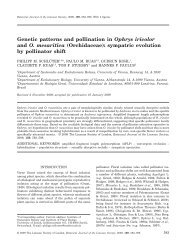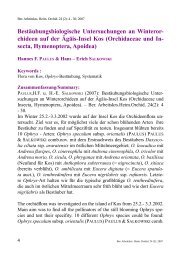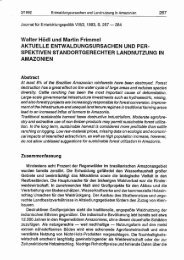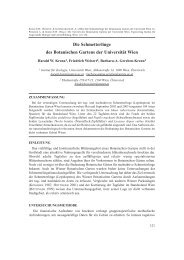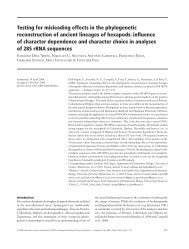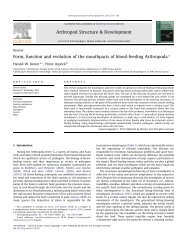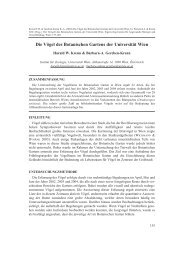Comparison of anuran acoustic communities of two habitat types in ...
Comparison of anuran acoustic communities of two habitat types in ...
Comparison of anuran acoustic communities of two habitat types in ...
Create successful ePaper yourself
Turn your PDF publications into a flip-book with our unique Google optimized e-Paper software.
Anuran <strong>acoustic</strong> <strong>communities</strong> <strong>in</strong> Sabah, Malaysia<br />
SALAMANDRA<br />
43<br />
3<br />
129-138<br />
Rhe<strong>in</strong>bach, 20 August 2007 ISSN 0036-3375<br />
<strong>Comparison</strong> <strong>of</strong> <strong>anuran</strong> <strong>acoustic</strong> <strong>communities</strong> <strong>of</strong> <strong>two</strong><br />
<strong>habitat</strong> <strong>types</strong> <strong>in</strong> the Danum Valley Conservation Area,<br />
Sabah, Malaysia<br />
Doris Pre<strong>in</strong><strong>in</strong>ger, Markus Böckle & Walter Hödl<br />
Abstract. We compared advertisement calls <strong>of</strong> frog assemblages <strong>in</strong> <strong>two</strong> different <strong>habitat</strong>s, (i) an open area<br />
along a dirt road with ponds and secondary vegetation; (ii) a fast flow<strong>in</strong>g stream <strong>in</strong> primary forest. Eleven<br />
frog species were recorded and significant differences <strong>in</strong> the dom<strong>in</strong>ant call frequencies between the <strong>two</strong><br />
observed frog <strong>communities</strong> were discovered. Stream-breed<strong>in</strong>g species produce higher frequencies than<br />
species occurr<strong>in</strong>g <strong>in</strong> the roadside <strong>habitat</strong>. Noisy <strong>habitat</strong>s have an <strong>in</strong>fluence on dom<strong>in</strong>ant frequency and<br />
demand <strong>acoustic</strong> adaptations to <strong>in</strong>crease the signal-to-noise ratio. Selective logg<strong>in</strong>g represents a major<br />
threat to stream-breed<strong>in</strong>g <strong>anuran</strong>s <strong>in</strong> Sabah. Pollution <strong>of</strong> clear water threatens the stream-dependent<br />
herpet<strong>of</strong>auna.<br />
Keywords. Amphibia, Anura, conservation, vocalisation, Malaysia.<br />
Introduction<br />
Selective logg<strong>in</strong>g has been the ma<strong>in</strong> cause <strong>of</strong><br />
disturbance to tropical forests <strong>in</strong> Southeast<br />
Asia (Marsh & Greer 1992, Willott et al.<br />
2000). Concession-based timber extraction<br />
and plantation establishment result <strong>in</strong> highly<br />
fragmented forests (McMorrow & Talip<br />
2001, Curran et al. 2004) and <strong>in</strong>crease<br />
river sediment yields (Douglas et al. 1993).<br />
The extent to which biodiversity is altered<br />
<strong>in</strong> selectively logged forest is an important<br />
conservation issue. Fragmentation, degradation<br />
and conversion <strong>of</strong> ra<strong>in</strong>forests affect the<br />
tropical herpet<strong>of</strong>auna (Alcala et al. 2004).<br />
About half the frog species <strong>in</strong> Southeast Asia<br />
are restricted to riparian <strong>habitat</strong>s and develop<br />
<strong>in</strong> streams (Inger 1969, Zimmerman &<br />
Simberl<strong>of</strong>f 1996). Most <strong>anuran</strong> stream-side<br />
<strong>communities</strong> <strong>in</strong> Borneo are known to breed<br />
<strong>in</strong> clear, turbulent water and are absent <strong>in</strong><br />
streams with silt bottoms and lack<strong>in</strong>g riffles<br />
and torrents (Inger & Voris 1993). Several<br />
<strong>anuran</strong> community studies have focused on<br />
environmental conditions such as vegetation,<br />
elevation, ra<strong>in</strong>fall and micro<strong>habitat</strong> (Inger<br />
1969, Duellman 1978, Inger & Voris<br />
1993, Gillespie et al. 2004). Apart from behavioural<br />
and morphological adaptations to<br />
the environment, frog assemblages also show<br />
<strong>acoustic</strong> differences. A prime factor separat<strong>in</strong>g<br />
species with<strong>in</strong> <strong>anuran</strong> assemblages<br />
is vocalization (Duellman & Trueb 1986).<br />
Acoustic partition<strong>in</strong>g through temporal and<br />
spectral features m<strong>in</strong>imizes competition and<br />
allows conspecific females to recognize <strong>in</strong>dividual<br />
signall<strong>in</strong>g males (Hödl 1977, Garcia-<br />
Rutledge & Nar<strong>in</strong>s 2001, Gerhardt &<br />
Huber 2002). The dom<strong>in</strong>ant frequency <strong>of</strong> a<br />
frog’s call is partially constra<strong>in</strong>ed by its body<br />
size (Kime et al. 2000). Snout-vent length and<br />
dom<strong>in</strong>ant frequency are negatively correlated<br />
(Littlejohn 1977, Duellman & Pyles 1983,<br />
Ryan & Brenowitz 1985). Sounds produced<br />
by waterfalls and fast-flow<strong>in</strong>g streams contribute<br />
to the ambient noise level. Dist<strong>in</strong>ct,<br />
<strong>acoustic</strong> <strong>habitat</strong> properties (“melotops”) demand<br />
different adaptations on animal vocalizations.<br />
In this study, species composition<br />
was determ<strong>in</strong>ed for <strong>two</strong> <strong>habitat</strong>s with<strong>in</strong> the<br />
Danum Valley Conservation Area (DVCA),<br />
a fast flow<strong>in</strong>g stream <strong>in</strong> the primary forest<br />
© 2007 Deutsche Gesellschaft für Herpetologie und Terrarienkunde e.V. (DGHT)<br />
http://www.salamandra-journal.com<br />
129
Doris Pre<strong>in</strong><strong>in</strong>ger et al.<br />
and a roadside <strong>habitat</strong> with secondary vegetation,<br />
and spectral and temporal features <strong>of</strong><br />
the <strong>acoustic</strong> signals were compared.<br />
Material and methods<br />
Study area<br />
From 10 January to13 March 2006, we studied<br />
frog <strong>communities</strong> <strong>in</strong> DVCA, Sabah, Malaysia.<br />
DVCA has an area <strong>of</strong> 43,800 ha <strong>of</strong> lowland<br />
tropical ra<strong>in</strong>forest and is located <strong>in</strong> the upper<br />
catchment area <strong>of</strong> the Segama River. The Danum<br />
Valley Field Centre (DVFC) is located<br />
on the western edge <strong>of</strong> the DVCA (4°57´40”<br />
N 117°48´00” E; all but 9% <strong>of</strong> the area is below<br />
760 m above sea level) from where a 2.8 km<br />
long trail leads south to the Tembal<strong>in</strong>g waterfall.<br />
The ra<strong>in</strong>y season <strong>in</strong> Sabah extends from<br />
December to March (Northeast Monsoon)<br />
with ra<strong>in</strong>fall peak dur<strong>in</strong>g February (monthly<br />
mean 788 mm). Annual precipitation is<br />
near 3000 mm with year-to-year fluctuation<br />
<strong>of</strong> about 100 mm. Mean annual temperature<br />
is 26.7°C with mean maximum 30.9°C and<br />
mean m<strong>in</strong>imum 22.5°C. Daily temperature<br />
fluctuations are noticeably more pronounced<br />
than the year-to-year fluctuations. In the period<br />
from January to March the highest recorded<br />
temperature was 32.5°C and the lowest<br />
was 20.3°C; mean relative humidity at<br />
the DVFC was 97.0% at 8:00h and 89.7% at<br />
14:00h. Daily ra<strong>in</strong>fall and temperature data<br />
from January to March 2006 derived from<br />
the Danum Valley weather station, which is<br />
ma<strong>in</strong>ta<strong>in</strong>ed by the staff <strong>of</strong> the Royal Society<br />
SE Asia Ra<strong>in</strong> Forest Research Programme.<br />
Sampl<strong>in</strong>g methods<br />
We focused on <strong>two</strong> macro<strong>habitat</strong> <strong>types</strong>. One<br />
is prist<strong>in</strong>e, the other disturbed. The Tembal<strong>in</strong>g<br />
River with<strong>in</strong> the primary dipterocarp forest<br />
at about 900 m elevation is a fast flow<strong>in</strong>g<br />
freshwater stream with rapids, waterfalls and<br />
no siltation. The selected disturbed <strong>habitat</strong><br />
was along a dirt road <strong>in</strong> the DVFC with secondary<br />
vegetation, ephemeral roadside pools<br />
fill<strong>in</strong>g seasonally with water and vary<strong>in</strong>g degrees<br />
<strong>of</strong> human disturbance. In both <strong>habitat</strong>s<br />
1000 m long and y-shaped transects were<br />
established and marked with coloured tape.<br />
We performed visual and <strong>acoustic</strong> encounter<br />
surveys. The search areas also <strong>in</strong>cluded adjacent<br />
riverbanks or vegetation up to a distance<br />
<strong>of</strong> 3 m to the water- or road-edge. Sampl<strong>in</strong>g<br />
was performed <strong>in</strong>dependent <strong>of</strong> prevail<strong>in</strong>g<br />
weather conditions. Each transect was sampled<br />
at least 20 times by <strong>two</strong> observers dur<strong>in</strong>g<br />
the day and dur<strong>in</strong>g nocturnal censuses. Repeated<br />
controls <strong>of</strong> the same transect on consecutive<br />
days were avoided to ensure <strong>in</strong>dependence<br />
<strong>of</strong> samples. To determ<strong>in</strong>e all call<strong>in</strong>g<br />
species, a 24-hour time period was sampled<br />
four times dur<strong>in</strong>g one month along both<br />
transects. After locat<strong>in</strong>g a vocaliz<strong>in</strong>g male,<br />
call record<strong>in</strong>gs were made from distances <strong>of</strong><br />
1 to 5 m us<strong>in</strong>g directional and surround microphones<br />
(Sennheiser Me 66, AKG D 190 E)<br />
and DAT- recorders (Sony DAT-Rec. TCD-<br />
D8). Micro<strong>habitat</strong> temperature and humidity<br />
were measured with a digital thermohygrometer<br />
(Testo 610 GM) before each record<strong>in</strong>g.<br />
Frogs were located at their rest<strong>in</strong>g sites,<br />
and if possible, captured and placed <strong>in</strong> plastic<br />
bags. Snout-vent length and snout-urostyle<br />
length were measured us<strong>in</strong>g a Wiha calliper<br />
(± 0.1mm). To differentiate between <strong>in</strong>dividuals<br />
we photographed and compared dorsal<br />
colour patterns. All <strong>in</strong>dividuals were released<br />
after tak<strong>in</strong>g their measurements.<br />
Data analysis<br />
We digitized and analysed the recorded calls<br />
with the sound-analysis s<strong>of</strong>tware Raven 1.2.1<br />
at a sampl<strong>in</strong>g frequency <strong>of</strong> 44.1 Hz and with<br />
a mono 16 bit PCM Input and a 10 Hz update<br />
rate at normal speed. Power spectra, sonograms<br />
and oscillograms <strong>of</strong> 1 to 5 advertisement<br />
calls were analyzed for each frog and<br />
the average dom<strong>in</strong>ant frequency, m<strong>in</strong>imum<br />
and maximum frequency, call duration,<br />
note duration, repetition rate and number<br />
130
Anuran <strong>acoustic</strong> <strong>communities</strong> <strong>in</strong> Sabah, Malaysia<br />
<strong>of</strong> notes, when applicable were calculated<br />
for each <strong>in</strong>dividual. Spectrogram views were<br />
produced with a Hann-filter with a sample<br />
size <strong>of</strong> 512 and a 3-dB filter bandwidth <strong>of</strong> 124<br />
Hz. The correlation between body size (SVL)<br />
and dom<strong>in</strong>ant frequency was calculated with<br />
a Spearman non-parametric correlation (p ≤<br />
0.05). ANOVA (p ≤ 0.05) was used to test for<br />
statistical differences, <strong>in</strong> SVL (mm) and dom<strong>in</strong>ant<br />
frequency (Hz) <strong>of</strong> advertisement calls,<br />
among frog assemblages <strong>in</strong> <strong>two</strong> <strong>habitat</strong>s. The<br />
<strong>in</strong>fluence <strong>of</strong> SVL and <strong>habitat</strong> on the dom<strong>in</strong>ant<br />
frequency <strong>of</strong> the frog species was calculated<br />
by an ANCOVA (p ≤ 0.05). S<strong>in</strong>ce the sample<br />
size for some <strong>anuran</strong> species tested was N = 1,<br />
the <strong>in</strong>fluence <strong>of</strong> SVL on dom<strong>in</strong>ant frequency<br />
was calculated twice: once corrected accord<strong>in</strong>g<br />
to number <strong>of</strong> <strong>in</strong>dividuals and once without<br />
correction. All statistical tests were produced<br />
with SPSS for Mac 11.0.4.<br />
(Fig. 5), Polypedates otilophus (Fig. 6), and<br />
Bufo asper (Fig. 7), Meristogenys orphnocnemis<br />
(Fig. 8), Microhyla sp. (Fig. 9), Staurois<br />
natator (Fig. 10), Staurois latopalmatus (Fig.<br />
11), respectively. No calls could be recorded<br />
for species without frequency data (Tab. 1). A<br />
total <strong>of</strong> 213 calls were analyzed. The dom<strong>in</strong>ant<br />
call frequencies <strong>of</strong> the <strong>anuran</strong> species are not<br />
dependent on the SVL <strong>of</strong> the vocaliz<strong>in</strong>g <strong>in</strong>dividuals<br />
(N = 11; c = -0.555; p ≤ 0.077; r 2 =<br />
0.30) (Fig. 13). Meristogenys orphnocnemis, a<br />
species found <strong>in</strong> the stream <strong>habitat</strong> produced<br />
the highest call<strong>in</strong>g frequency (7205.0 Hz).<br />
Frog species from the torrent are above the<br />
Results<br />
Dur<strong>in</strong>g the sampl<strong>in</strong>g period 20 frog species<br />
were found. Eleven frog species were recorded,<br />
six along the disturbed area and five with<strong>in</strong><br />
the prist<strong>in</strong>e <strong>habitat</strong>: Fejervarya nicobariensis<br />
(Fig. 1), Fejervarya limnocharis (Fig. 2),<br />
Rhacophorus dulitensis (Fig. 3), Polypedates<br />
leucomystax (Fig. 4), Polypedates macrotis<br />
Fig. 2. Spectrogram (frequency [kHz]) and waveform<br />
(rel. amplitude [kUnit] = proportional to<br />
sound pressure <strong>of</strong> the record<strong>in</strong>g) <strong>of</strong> the advertisement<br />
call <strong>of</strong> Fejervarya limnocharis. Temperature<br />
dur<strong>in</strong>g record<strong>in</strong>g 24.6 °C.<br />
Fig. 1. Spectrogram (frequency [kHz]) and waveform<br />
(rel. amplitude [kUnit] = proportional to<br />
sound pressure <strong>of</strong> the record<strong>in</strong>g) <strong>of</strong> the advertisement<br />
call and non-collected specimen <strong>of</strong> Fejervarya<br />
nicobariensis. Temperature dur<strong>in</strong>g record<strong>in</strong>g<br />
25.4 °C.<br />
Fig. 3. Spectrogram (frequency [kHz]) and waveform<br />
(rel. amplitude [kUnit] = proportional to<br />
sound pressure <strong>of</strong> the record<strong>in</strong>g) <strong>of</strong> the advertisement<br />
call and non-collected specimen <strong>of</strong> Rhacophorus<br />
dulitensis. Temperature dur<strong>in</strong>g record<strong>in</strong>g 26.3<br />
°C.<br />
131
Doris Pre<strong>in</strong><strong>in</strong>ger et al.<br />
Fig. 4. Spectrogram (frequency [kHz]) and waveform<br />
(rel. amplitude [kUnit] = proportional to<br />
sound pressure <strong>of</strong> the record<strong>in</strong>g) <strong>of</strong> the advertisement<br />
call and non-collected specimen <strong>of</strong> Polypedates<br />
leucomystax. Temperature dur<strong>in</strong>g record<strong>in</strong>g<br />
25.0 °C.<br />
Fig. 6. Spectrogram (frequency [kHz]) and waveform<br />
(rel. amplitude [kUnit] = proportional to<br />
sound pressure <strong>of</strong> the record<strong>in</strong>g) <strong>of</strong> the advertisement<br />
call and non-collected specimen <strong>of</strong> Polypedates<br />
otilophus. Temperature dur<strong>in</strong>g record<strong>in</strong>g<br />
25.4 °C.<br />
Fig. 5. Spectrogram (frequency [kHz]) and waveform<br />
(rel. amplitude [kUnit] = proportional to<br />
sound pressure <strong>of</strong> the record<strong>in</strong>g) <strong>of</strong> the advertisement<br />
call and non-collected specimen <strong>of</strong> Polypedates<br />
macrotis. Temperature dur<strong>in</strong>g record<strong>in</strong>g<br />
24.9 °C.<br />
calculated regression except Bufo asper and<br />
Microhyla sp. All frog species <strong>in</strong> the roadside<br />
<strong>habitat</strong> are below the calculated regression.<br />
The largest frog species was Polypedates<br />
otilophus with a dom<strong>in</strong>ant call frequency <strong>of</strong><br />
1,033.6 Hz. No frog species with a dom<strong>in</strong>ant<br />
call frequency below 1,000 Hz was recorded.<br />
Frequencies <strong>of</strong> advertisement calls <strong>of</strong> <strong>anuran</strong><br />
species found <strong>in</strong> the stream transect are higher<br />
than call frequencies recorded <strong>of</strong> species<br />
occurr<strong>in</strong>g <strong>in</strong> the roadside <strong>habitat</strong> (Fig. 14) (N<br />
Fig. 7. Spectrogram (frequency [kHz]) and waveform<br />
(rel. amplitude [kUnit] = proportional to<br />
sound pressure <strong>of</strong> the record<strong>in</strong>g) <strong>of</strong> the advertisement<br />
call and non-collected specimen <strong>of</strong> Bufo<br />
asper. Temperature dur<strong>in</strong>g record<strong>in</strong>g 24.6 °C.<br />
= 11; df = 1; F = 7.315, p = 0.024). Dom<strong>in</strong>ant<br />
frequency is not dependent on the SVL (N =<br />
11; df = 1; F = 3.822, p = 0.082) but the <strong>in</strong>fluence<br />
<strong>of</strong> the <strong>habitat</strong> is significant (N = 11; df =<br />
1; F = 7.031, p = 0.029). If the number <strong>of</strong> analyzed<br />
<strong>in</strong>dividuals is <strong>in</strong>cluded, the dependency<br />
<strong>of</strong> the dom<strong>in</strong>ant frequency, the <strong>in</strong>fluence<br />
<strong>of</strong> SVL (N = 11; df = 1; F = 0.519, p = 0.049)<br />
and the <strong>in</strong>fluence <strong>of</strong> the <strong>habitat</strong> (N = 11; df =<br />
1; F = 11.435, p = 0.010) become more significant.<br />
132
Anuran <strong>acoustic</strong> <strong>communities</strong> <strong>in</strong> Sabah, Malaysia<br />
Fig. 8. Spectrogram (frequency [kHz]) and waveform<br />
(rel. amplitude [kUnit] = proportional to<br />
sound pressure <strong>of</strong> the record<strong>in</strong>g) <strong>of</strong> the advertisement<br />
call and non-collected specimen <strong>of</strong> Meristogenys<br />
orphnocnemis. Temperature dur<strong>in</strong>g record<strong>in</strong>g<br />
24.8 °C.<br />
Fig. 10. Spectrogram (frequency [kHz]) and waveform<br />
(rel. amplitude [kUnit] = proportional to<br />
sound pressure <strong>of</strong> the record<strong>in</strong>g) <strong>of</strong> the advertisement<br />
call and non-collected specimen <strong>of</strong> Staurois<br />
natator. Temperature dur<strong>in</strong>g record<strong>in</strong>g 25.3 °C.<br />
Fig. 9. Spectrogram (frequency [kHz]) and waveform<br />
(rel. amplitude [kUnit] = proportional to<br />
sound pressure <strong>of</strong> the record<strong>in</strong>g) <strong>of</strong> the advertisement<br />
call and non-collected specimen <strong>of</strong> Microhyla<br />
sp. Temperature dur<strong>in</strong>g record<strong>in</strong>g 25.3 °C.<br />
Discussion<br />
Fig. 11. Spectrogram (frequency [kHz]) and waveform<br />
(rel. amplitude [kUnit] = proportional to<br />
sound pressure <strong>of</strong> the record<strong>in</strong>g) <strong>of</strong> the advertisement<br />
call and non-collected specimen <strong>of</strong> Staurois<br />
latopalmatus. Temperature dur<strong>in</strong>g record<strong>in</strong>g 25.2<br />
°C.<br />
The comparison <strong>of</strong> <strong>two</strong> local frog assemblages<br />
<strong>in</strong> different <strong>habitat</strong>s shows that advertisement<br />
calls <strong>of</strong> frog species liv<strong>in</strong>g <strong>in</strong> noisy<br />
environments constra<strong>in</strong> higher frequencies.<br />
Fast flow<strong>in</strong>g streams and waterfalls produce<br />
low-frequency-dom<strong>in</strong>ated noise which may<br />
present a selective force for stream-breed<strong>in</strong>g<br />
species (Hödl & Amézquita 2001, Feng et<br />
al. 2006). The high-frequency calls exceed<br />
the constant ambient noise level. Spectrograms<br />
<strong>of</strong> streams show high sound pressure<br />
levels <strong>in</strong> low frequencies and lower sound<br />
pressure levels <strong>in</strong> frequencies above 3,000<br />
Hz (Hödl & Amézquita 2001, Feng et al.<br />
2006, authors’ unpublished data). Environmental<br />
constra<strong>in</strong>ts should have an effect on<br />
the evolution <strong>of</strong> signals (Nar<strong>in</strong>s & Zelick<br />
1988). Selection favors signals that m<strong>in</strong>imize<br />
the effects <strong>of</strong> background noise and <strong>in</strong>terfer<strong>in</strong>g<br />
signals from other species (Endler<br />
1993). Riparian frog species are <strong>acoustic</strong>ally<br />
well adapted to their environment and show<br />
133
Doris Pre<strong>in</strong><strong>in</strong>ger et al.<br />
a<br />
b<br />
c<br />
d<br />
e<br />
f<br />
g<br />
h<br />
Fig. 12. a) Fejervarya nicobariensis, b) Fejervarya limnocharis, c) Rhacophorus dulitensis, d) Polypedates<br />
leucomystax, e) Polypedates macrotis, f) Polypedates otilophus, g) Bufo asper, h) Meristogenys orphnocnemis,<br />
i) Microhyla sp., j) Staurois natator, k) Staurois latopalmatus. Photos: M. Böckle, W. Hödl, T.<br />
Reis.<br />
134
Anuran <strong>acoustic</strong> <strong>communities</strong> <strong>in</strong> Sabah, Malaysia<br />
i<br />
j<br />
k<br />
strong <strong>habitat</strong> affiliations. With the exception<br />
<strong>of</strong> Bufo asper the mean dom<strong>in</strong>ant frequency<br />
was above 3.9 kHz for frogs call<strong>in</strong>g <strong>in</strong> the undisturbed<br />
<strong>habitat</strong>. A possible explanation for<br />
the call frequency <strong>in</strong> B. asper could be that it<br />
prefers stream banks, with small riffles that<br />
produced less background noise. Additionally,<br />
dom<strong>in</strong>ant frequency is determ<strong>in</strong>ed by<br />
SVL. Larger frogs call with lower frequencies<br />
than smaller frogs (Littlejohn 1977, Kime<br />
et al. 2000). The sampl<strong>in</strong>g size was probably<br />
too small to produce the dependency <strong>of</strong><br />
SVL on dom<strong>in</strong>ant frequency. Only weighted<br />
data were able to show the <strong>in</strong>fluence. All species<br />
found <strong>in</strong> the disturbed roadside <strong>habitat</strong><br />
call with lower frequencies and less constant<br />
noise is emitted by the surround<strong>in</strong>g environment.<br />
This gives rise to the question why a<br />
high proportion <strong>of</strong> species breeds close to<br />
fast flow<strong>in</strong>g streams (Inger 1969). Zimmerman<br />
& Simberl<strong>of</strong>f (1996) showed that reproductive<br />
mode and developmental <strong>habitat</strong><br />
are strongly associated with phylogeny. The<br />
same limited set <strong>of</strong> ecological and reproductive<br />
traits is shared by ranids, pelopatids and<br />
rhacophorids. Environmental conditions and<br />
<strong>in</strong>terspecific <strong>in</strong>teractions may have led to adaptations,<br />
but local selection on species can<br />
not be counted <strong>in</strong>dependent when closely related<br />
species occur <strong>in</strong> the same community.<br />
Phylogeny was not <strong>in</strong>cluded <strong>in</strong> our analysis<br />
and a certa<strong>in</strong> bias may result from the fact<br />
that <strong>two</strong> species <strong>of</strong> the genus Staurois are<br />
present at the stream <strong>habitat</strong>. Advertisement<br />
calls are important determ<strong>in</strong>ants <strong>of</strong> reproductive<br />
success and could have evolved <strong>in</strong> a<br />
common ancestor. However, we were able<br />
to record five species <strong>of</strong> the family <strong>of</strong> ranids,<br />
three at the stream (Staurois latopalmatus,<br />
S. natator and Meristogenys orphnocnemis)<br />
and <strong>two</strong> along the roadside (Fejervarya nicobariensis<br />
and F. limnocharis). All three ranid<br />
species recorded along the stream produce<br />
advertisement calls <strong>in</strong> which the dom<strong>in</strong>ant<br />
frequencies are above the calculated l<strong>in</strong>ear<br />
regression l<strong>in</strong>e (Fig. 13). Although morphological<br />
and phylogenetic limitations constra<strong>in</strong><br />
frog vocalizations, selective pressures<br />
such as environmental factors have resulted<br />
<strong>in</strong> a diversity <strong>of</strong> advertisement calls (Duellman<br />
& Trueb 1986). Acoustic partition<strong>in</strong>g<br />
and <strong>in</strong>creas<strong>in</strong>g the signal-to-noise ratio is a<br />
prerequisite for frogs liv<strong>in</strong>g along torrents<br />
and streams. The <strong>in</strong>fluence <strong>of</strong> the <strong>habitat</strong> on<br />
advertisement calls should emphasize the<br />
importance <strong>of</strong> micro<strong>habitat</strong> composition on<br />
frog assemblages. Most recorded species are<br />
threatened by <strong>habitat</strong> loss (Tab. 1). Deforestation<br />
and subsequent siltation <strong>of</strong> streams and<br />
rivers are the major threats to most streambreed<strong>in</strong>g<br />
species <strong>in</strong> Sabah. Out <strong>of</strong> twelve species<br />
found along the stream, three are classified<br />
as “near threatened” accord<strong>in</strong>g to the<br />
135
Doris Pre<strong>in</strong><strong>in</strong>ger et al.<br />
Fig. 13. Influence <strong>of</strong> SVL on dom<strong>in</strong>ant frequency <strong>of</strong> the species advertisement call (y = -55.49x +<br />
5472.71). Frog species <strong>of</strong> the stream transect are marked with a square, those from the roadside <strong>habitat</strong><br />
with a circle.<br />
Fig. 14. Dom<strong>in</strong>ant call frequencies <strong>of</strong> the <strong>anuran</strong><br />
species from <strong>two</strong> different <strong>habitat</strong> <strong>types</strong>. Species<br />
along the stream call with higher frequencies than<br />
frog species <strong>in</strong> the roadside <strong>habitat</strong>.<br />
IUCN Red List status (Tab. 1). Inger & Voris<br />
(1993) found that a stream with a silt bottom<br />
completely lacked all the species known to<br />
breed along clear and fast flow<strong>in</strong>g streams.<br />
Selective logg<strong>in</strong>g changes the water chemistry<br />
considerably <strong>in</strong> nearby streams. Sediment<br />
yields <strong>of</strong> streams are 18 times higher with<strong>in</strong><br />
the next five months <strong>in</strong> selectively logged areas<br />
(Douglas et al. 1992, 1993). The <strong>in</strong>crease<br />
<strong>in</strong> sedimentation levels has a clear effect on<br />
larval <strong>anuran</strong>s and on reproduction <strong>of</strong> several<br />
stream-breed<strong>in</strong>g species. Frog assemblages<br />
as those found at the Tembal<strong>in</strong>g River show<br />
the importance <strong>of</strong> conservation areas like<br />
Danum Valley. On the other hand more micro<strong>habitat</strong>s<br />
are created through reduced impact<br />
logg<strong>in</strong>g which attracts frog species that<br />
are normally not found <strong>in</strong> primary forests<br />
(e.g., Polypedates macrotis, Fejervarya nicobariensis<br />
and Rhacophorus pardalis) (Wong<br />
<strong>in</strong> press). We believe that disturbed areas<br />
such as those around the Danum Valley Field<br />
Center and adjacent roads conta<strong>in</strong> suitable<br />
ponds and breed<strong>in</strong>g <strong>habitat</strong>s for disturbancetolerant<br />
breeders, but the large destruction<br />
and fragmentation <strong>of</strong> primary forest poses a<br />
136
Anuran <strong>acoustic</strong> <strong>communities</strong> <strong>in</strong> Sabah, Malaysia<br />
Tab. 1. List <strong>of</strong> <strong>anuran</strong> species found <strong>in</strong>clud<strong>in</strong>g weight, snout-vent length (SVL), dom<strong>in</strong>ant call frequency<br />
(DF) and IUCN Red List status. Habitat: 1 = stream, 2 = road edge (numbers <strong>in</strong> parentheses are the absolute<br />
number <strong>of</strong> <strong>in</strong>dividuals measured); weight [g]; SVL [mm]; dom<strong>in</strong>ant frequency, DF [Hz] (number<br />
<strong>of</strong> <strong>in</strong>dividuals/number <strong>of</strong> analyzed calls); major threat: HL = <strong>habitat</strong> loss, P = pollution <strong>of</strong> streams and<br />
rivers, ID = <strong>in</strong>frastructure development, N = none; Red List status accord<strong>in</strong>g to IUCN et al. (2006).<br />
species <strong>habitat</strong> SVL DF major threat IUCN Red List<br />
status<br />
Bufo asper 1 76.2 (1) 1,031.2 (1/9) HL/P least concern<br />
Meristogenys orphnocnemis 1 30.2 (4) 7,205.0 (1/6) HL/P least concern<br />
Microhyla sp. 1 14.9 (5) 3,969.3 (4/25) - -<br />
Staurois natator 1 33.9 (4) 4,746.0 (3/19) HL/ID least concern<br />
Staurois latopalmatus 1 47.7 (11) 5,149.4 (5/20) HL/P least concern<br />
Ansonia longidigita 1 - - HL/P near threatened<br />
Ansonia sp<strong>in</strong>ulifer 1 3.2 (1) - HL/P near threatened<br />
Leptobrachium abbotti 1 56.5 (5) - HL least concern<br />
Limnonectes lepor<strong>in</strong>us 1 106.8 (1) - HL least concern<br />
Rana picturata 1 39.8 (2) - HL least concern<br />
Pedostibes rugosus 1 - - HL/P near threatened<br />
Chaper<strong>in</strong>a fusca 1 18.8 (1) - HL least concern<br />
Chaper<strong>in</strong>a fusca 2 - - HL least concern<br />
Polypedates leucomystax 2 30.0 (7) 2,056.7 (4/35) N least concern<br />
Polypedates macrotis 2 57.0 (5) 1,388.9 (1/3) N least concern<br />
Polypedates otilophus 2 81.1 (9) 1,033.6 (1/2) HL least concern<br />
Fejervarya limnocharis 2 33.4 (3) 1,274.0 (3/3) - least concern<br />
Fejervarya nicobariensis 2 41.2 (6) 3,169.7 (5/44) HL/N least concern<br />
Rhacophorus dulitensis 2 46.6 (4) 1,868.6 (5/47) HL near threatened<br />
Rhacophorus pardalis 2 43.5 (6) - HL least concern<br />
Occidozyga laevis 2 31.0 (10) - N least concern<br />
major threat to the characteristic herpet<strong>of</strong>auna<br />
<strong>of</strong> Sabah.<br />
Acknowledgements<br />
We thank the Danum Valley Management Committee,<br />
the Economic Plan<strong>in</strong>g Unit, the Sabah<br />
Wildlife Department and the Universiti <strong>of</strong> Malaysia<br />
Sabah for giv<strong>in</strong>g us the opportunity to work<br />
<strong>in</strong> the Danum Valley Conservation Area. Special<br />
thanks go to the Royal Society (RS) and Glen<br />
Reynolds for their support and commitment to<br />
make this project possible. Julia Fell<strong>in</strong>g and<br />
Karol<strong>in</strong>e Schmidt assisted dur<strong>in</strong>g our fieldwork<br />
and Markus Gme<strong>in</strong>er did the photo edit<strong>in</strong>g. We<br />
are very thankful for the statistical help <strong>of</strong> Adolfo<br />
Amézquita. Anna Wong acted as our local collaborator.<br />
F<strong>in</strong>ancial support was given by the University<br />
<strong>of</strong> Vienna (Brief Scientific Stays Abroad)<br />
and the DGHT (Wilhelm-Peters-Fonds). The<br />
Department <strong>of</strong> Evolutionary Biology (University<br />
<strong>of</strong> Vienna) provided the necessary field equipment.<br />
Last but not least we thank the DVCA and<br />
RS staff for keep<strong>in</strong>g our spirits up.<br />
References<br />
Alcala, E.L., A.C. Alcala & C.N. Dol<strong>in</strong>o<br />
(2004): Amphibians and reptiles <strong>in</strong> tropical<br />
ra<strong>in</strong>forest fragments on Negros Island, the<br />
Philipp<strong>in</strong>es. – Environ. Conserfv., 31: 254-261.<br />
Curran, L.M., S.N. Trigg, A.K. McDonald, D.<br />
Astiani, Y.M. Hardiono, P. Siregar, I. Caniago<br />
& E. Kasischke (2004): Lowland forest<br />
loss <strong>in</strong> protected areas <strong>of</strong> Indonesian Borneo.<br />
– Science, 303: 1000-1003.<br />
Douglas, I., T. Greer, K. Bid<strong>in</strong> & M. Spilsbury<br />
(1993): Impacts <strong>of</strong> ra<strong>in</strong>forest logg<strong>in</strong>g on river<br />
systems and <strong>communities</strong> <strong>in</strong> Malaysia and<br />
Kalimantan. – Global Ecol. Biogeogr. Lett., 3:<br />
245-252.<br />
Douglas, I., T. Spencer, T. Greer, K. Bid<strong>in</strong> &<br />
W. S<strong>in</strong>un (1992): The impact <strong>of</strong> selective commercial<br />
logg<strong>in</strong>g on stream hydrology, chemistry<br />
and sediment loads <strong>in</strong> the Ulu Segama Ra<strong>in</strong><br />
Forest, Sabah, Malaysia. – Phil. Trans. R. Soc.<br />
Lond. B, 235: 397-406.<br />
Duellman, W.E. (1978): The biology <strong>of</strong> an equatorial<br />
herpet<strong>of</strong>auna <strong>in</strong> Amazonian Ecuador. –<br />
137
Doris Pre<strong>in</strong><strong>in</strong>ger et al.<br />
Misc. Publ. Mus. Nat. Hist. Univ. Kansas, 65:<br />
1-352.<br />
Duellman, W.E. & A.R. Pyles (1983): Acoustic<br />
resource partition<strong>in</strong>g <strong>in</strong> <strong>anuran</strong> <strong>communities</strong>.<br />
– Copeia, 1983: 639-649.<br />
Duellman, W.E. & L. Trueb (1986): Biology <strong>of</strong><br />
amphibians. – McGraw Hill, New York.<br />
Endler, J.A. (1993): Some general comments on<br />
the evolution and design <strong>of</strong> animal communication<br />
systems. – Phil. Trans. R. Soc. Lond. B,<br />
340: 215-225.<br />
Feng, A.S., P.M. Nar<strong>in</strong>s, C.-H. Xu, W.-Y. L<strong>in</strong>, Z.-<br />
L. Yu, Q. Qiu, Z.-M. Xu & J.-X. Shen (2006):<br />
Ultrasonic communication <strong>in</strong> frogs. – Nature,<br />
440: 333-336.<br />
Garcia-Rutledge, E.J. & P.M. Nar<strong>in</strong>s (2001):<br />
Shared <strong>acoustic</strong> resources <strong>in</strong> an Old World frog<br />
community. – Herpetologica, 57: 104-116.<br />
Gerhardt, H.C. & F. Huber (2002): Acoustic<br />
communication <strong>in</strong> <strong>in</strong>sects and <strong>anuran</strong>s. – Univ.<br />
Chicago Press, Chicago and London.<br />
Gillespie, G.R., D. Lockie, M.P. Scroggie &<br />
D.T. Iskandar (2004): Habitat use by streambreed<strong>in</strong>g<br />
frogs <strong>in</strong> south-east Sulawesi, with<br />
some prelim<strong>in</strong>ary observations on community<br />
organization. – J. Trop. Ecol., 20: 439-448.<br />
Hödl, W. (1977): Call differences and call<strong>in</strong>g site<br />
segregation <strong>in</strong> <strong>anuran</strong> species from central<br />
Amazonian float<strong>in</strong>g meadows. – Oecologia,<br />
28: 351-363.<br />
Hödl, W. & A. Amézquita (2001): Visual signal<strong>in</strong>g<br />
<strong>in</strong> <strong>anuran</strong> amphibians. – Pp. 121-141 <strong>in</strong>:<br />
Ryan M.J. (ed.): Anuran communication. –<br />
Smithsonian Inst. Press, Wash<strong>in</strong>gton.<br />
Inger, R.F. (1969): Organization <strong>of</strong> <strong>communities</strong><br />
<strong>of</strong> frogs along small ra<strong>in</strong> forest streams <strong>in</strong><br />
Sarawak. – J. Anim. Ecol., 38: 123-148.<br />
Inger, R.F. & H.K. Voris (1993): A comparison<br />
<strong>of</strong> amphibian <strong>communities</strong> through time and<br />
from place to place <strong>in</strong> Bornean forests. – J.<br />
Tropical Ecology, 9: 409-433.<br />
IUCN, Conservation International, and Nature-<br />
Serve. (2006): Global Amphibian Assessment.<br />
– Wash<strong>in</strong>gton. [www.globalamphibians.org,<br />
latest accessed 15 December 2006]<br />
Kime, N.M., W.R. Turner & M.J. Ryan (2000):<br />
The transmission <strong>of</strong> advertisement calls <strong>in</strong><br />
Central American frogs. – Behav. Ecol., 11: 71-<br />
83.<br />
Littlejohn, M.J. (1977): Long range <strong>acoustic</strong><br />
communication <strong>in</strong> <strong>anuran</strong>s. - Pp 263-294 <strong>in</strong>:<br />
Taylor, D. H & S.I. Guttman (eds.), The reproductive<br />
biology <strong>of</strong> amphibians. – Plenum<br />
Press, New York.<br />
Marsh, C.W. & A.G. Greer (1992): Forest landuse<br />
<strong>in</strong> Sabah, Malaysia: An <strong>in</strong>troduction to Danum<br />
Valley. – Phil. Trans. R. Soc. Lond. B, 335:<br />
331-339.<br />
McMorrow, J. & M.A. Talip (2001): Decl<strong>in</strong>e <strong>of</strong><br />
forest area <strong>in</strong> Sabah, Malaysia: Relationship to<br />
state policies, land code and land capability. –<br />
Global Environ. Change, 11: 217-230.<br />
Nar<strong>in</strong>s, P.M. & R. Zelick (1988): The effects <strong>of</strong><br />
noise on auditory process<strong>in</strong>g and behavior <strong>in</strong><br />
amphibians. - pp. 511-536 <strong>in</strong>: Fritzsch, B., M.<br />
Ryan, W. Wilczynski, T. Hether<strong>in</strong>gton &<br />
W. Walkowiak (eds.), The evolution <strong>of</strong> the<br />
amphibian auditory system. – John Wiley &<br />
Sons, New York.<br />
Ryan, M.J. & E.A. Brenowitz (1985): The role <strong>of</strong><br />
body size, phylogeny, and ambient noise <strong>in</strong> the<br />
evolution <strong>of</strong> bird song. – Amer. Nat., 126: 87-<br />
100.<br />
Willott, S.J., D.C. Lim, S.G. Compton & S.L.<br />
Sutton (2000): Effects <strong>of</strong> selective logg<strong>in</strong>g on<br />
the butterflies <strong>of</strong> a Bornean ra<strong>in</strong>forest. – Conserv.<br />
Biol., 14: 1055-1065.<br />
Wong, A. (<strong>in</strong> press): The impact <strong>of</strong> forestry practices<br />
on frog <strong>communities</strong> <strong>in</strong> Sabah, Malaysia.<br />
– PhD Dissertation. Universiti Putra Malaysia,<br />
Kota K<strong>in</strong>abalu, Malaysia.<br />
Zimmerman, B. & D. Simberl<strong>of</strong>f (1996): An historical<br />
<strong>in</strong>terpretation <strong>of</strong> <strong>habitat</strong> use by frogs <strong>in</strong><br />
a Central Amazonian forest. – J. Biogeogr., 23:<br />
27-46.<br />
Manuscript received: 24 August 2006<br />
Authors’ addresses: Doris Pre<strong>in</strong><strong>in</strong>ger, Markus Böckle, Walter Hödl, Department for Evolutionary<br />
Biology, University <strong>of</strong> Vienna, Althanstrasse 14, A-1090 Vienna, Austria, E-Mails: doris_<br />
pre<strong>in</strong><strong>in</strong>ger@hotmail.com; markus.boeckle@gmail.com; walter.hoedl@univie.ac.at.<br />
138



